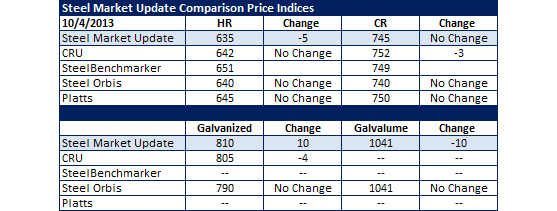Steel Products Prices North America

SMU Comparison Price Indices: Little to No Movement
Written by John Packard
October 6, 2013
The various steel indices followed by Steel Market Update showed very little change in their pricing assessments of flat rolled steel coils. Most of the indexes saw prices as moving sideways as we wait for buyers to digest the latest offerings from the domestic steel mills. In the case of Steel Market Update we collected a slightly wider range in hot rolled ($620-$650) this week which brought our number down $5 per ton but, over the past six weeks pricing has barely budged.

FOB Points for each index:
SMU: Domestic Mill, East of the Rockies.
CRU: Midwest Mill, East of the Rockies.
SteelBenchmarker: Domestic Mill, East of the Mississippi.
SteelOrbis: Midwest Domestic Mill.
Platts: Within 200-300 mile radius of Northern Indiana Domestic Mill.

John Packard
Read more from John PackardLatest in Steel Products Prices North America

CRU: Q3 will be the lowest point in current sheet price cycle
CRU Principal Analyst Shankhadeep Mukherjee expects a restocking cycle for steel sheet products in most parts of the world due to either low inventories or seasonally stronger demand.

CRU: US rebar and wire rod prices rise alongside S232 increase
CRU Senior Steel Analyst Alexandra Anderson discusses current market and pricing dynamics for long steel products in the US.

SMU Price Ranges: Sheet and plate steady ahead of Independence Day
Sheet and plate prices were little changed in the shortened week ahead of Independence Day, according to SMU’s latest check of the market.

Nucor maintains plate prices, opens August order book
Nucor aims to keep plate prices flat again with the opening of its August order book.

Nucor CSP remains level at $900/ton
Nucor maintained its weekly list price for hot-rolled (HR) coil this week, following two consecutive increases.
